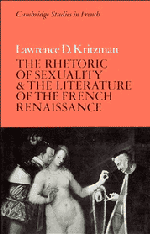Book contents
- Frontmatter
- Contents
- List of abbreviations
- Dedication
- Acknowledgments
- Introduction
- PART I RHETORICS OF GENDER
- PART II FIGURES OF THE BODY
- A DISFIGURING THE FEMININE
- B THE TEXT AS BODY
- PART III ALLEGORIES OF REPRESSION
- Notes
- Bibliography of works cited
- Index of names
- Subject index
- Cambridge Studies in French
- Frontmatter
- Contents
- List of abbreviations
- Dedication
- Acknowledgments
- Introduction
- PART I RHETORICS OF GENDER
- PART II FIGURES OF THE BODY
- A DISFIGURING THE FEMININE
- B THE TEXT AS BODY
- PART III ALLEGORIES OF REPRESSION
- Notes
- Bibliography of works cited
- Index of names
- Subject index
- Cambridge Studies in French
Summary
The essays in this book have been written over a number of years in the wake of the revolution in French critical theory and its transatlantic exportation. They mark the trajectory of my intellectual development from an interest in literary formalism and the “literariness” of the text to post-structuralist concerns, particularly the powerful convergence of psychoanalysis, gender theory, and a cultural semiotics conditioned by various intertextual traditions. I have chosen to discuss the question of the rhetoric of sexuality in its many formulations in the works of sixteenth-century French writers, ranging from Rabelais and Montaigne to Marot, Marguerite de Navarre, Pernette du Guillet, Scève, and Ronsard. By focusing on the issue of rhetoric, I have been led to examine the enigmas that haunt literary texts and the ways in which the topoi of sexuality reveal a work's underlying self-conscious preoccupations. Implicit in my readings of these early modern texts is the conviction I share with Perry Meisel – who warns against the dangers inherent in Freud's literary speculations as psychosexual reductions – that the mechanisms of a psychoanalytic reading of literary work are already inscribed in the mechanisms of its language.
Recent criticism has amply demonstrated how the laws of unconscious desire are played out in a text's representational modes. In departing from the theoretical presuppositions of classical applied psychoanalytic criticism, relating a somewhat positivistic rapport between author and text, I too have been concerned with mapping the strategies deployed to figure the libido of the writing subject.
- Type
- Chapter
- Information
- Publisher: Cambridge University PressPrint publication year: 1991

